Heading to Chaityabhoomi: Pilgrimages of Remembrance
Abstract
:1. Introduction
2. Ambedkar’s Mahāparinirvāṇa: A Starting Point for Remembrance Journeys
The news that Babasaheb’s ashes were on the train traveled before us. At every station hundreds of people crowded to see the urn. The sight of people crying uncontrollably was enough to move the heart. Thousands of people thronged to see the urn at Nagpur, and when we emerged from the train [from Bombay to Nagpur] carrying it with us, a wild shout of lamentation came from this mass of people.During the trip I stored all of the sights calmly in my mind. While viewing the funeral pyre in Mumbai I maintained a calm and cool manner, keeping the words of the Buddha fixed in my mind: ‘This body will be destroyed; death is inevitable’. However, hearing the cry from the masses in Nagpur, my heart trembled. Without my being aware of it, tears began to fall from my eyes, and I began to cry along with everyone else.
3. Ambedkar’s Shrine: Goal of the Pilgrims
4. Site of Memory, Pilgrimages, and Politics
5. Conclusions
Conflicts of Interest
References
- Ambedkar, B. R. 2016. Personal communication in Dadar. January 20. [Google Scholar]
- Bahujan Samaj Party. n.d. Bharat Ratna Dr. Bhimrao Ramji Ambarkar (Babasaheb). Available online: http://bspindia.org/bhimrao-ambedkar.php (accessed on 15 January 2018).
- Census of India. 2001. Maharashtra: Data Highlights: The Scheduled Castes. Available online: http://censusindia.gov.in/Tables_Published/SCST/dh_sc_maha.pdf (accessed on 15 January 2018).
- Census of India. 2011. Maharashtra: Population Growth: Levels and Trends. Available online: http://censusindia.gov.in/2011-prov-results/data_files/maharastra/7-%20Chapter%20-%204.pdf (accessed on 15 January 2018).
- Chamadia, Anil. 2016. Babri Masjid & Ambedkar: How 6 Dec can be a day to mark Dalit-Muslim unity. Catchnews. Available online: http://www.catchnews.com/india-news/babri-masjid-ambedkar-how-6-dec-can-be-a-day-to-mark-dalit-muslim-unity-1481035089.html (accessed on 15 January 2018).
- Dehejia, Vidya. 1972. Early Buddhist Rock Temples. A Chronological Survey. London: Thames and Hudson. [Google Scholar]
- Harvey, Peter. 1984. The Symbolism of the Early Stūpa. Journal of the International Association of Buddhist Studies 7: 67–94. [Google Scholar]
- Jadhav, Praveen. 2007. Ambedkar’s People in India: With Reference to “Chaityabhoomi”. New Delhi: Rajat Publications. [Google Scholar]
- Jaffrelot, Christophe. 2005. Dr. Ambedkar and Untouchability: Analysing and Fighting Caste. London: Hurst & Co. [Google Scholar]
- Joshil, Prakash. 2011. NCP yet to finalize stand on renaming Dadar station. The Times of India. Available online: https://timesofindia.indiatimes.com/city/mumbai/NCP-yet-to-finalize-stand-on-renaming-Dadar-station/articleshow/8670849.cms (accessed on 17 January 2018).
- Keer, Dhananjay. 1990. Dr. Ambedkar: Life and Mission. Mumbai: Popular Prakashan. [Google Scholar]
- Khizhnyak, Olga. 2008. Stupa: Nachalo Formirovaniya Buddiyskogo Kulta. St Petersburg: St Petersburg University. (In Russian) [Google Scholar]
- Masselos, Jim. n.d. The Life of Dead Bodies. Corporality and Memory in Pre-Independence Bombay (Manuscript). Sydney: University of Sydney.
- Moon, Vasant. 2002. Growing Up Untouchable in India. A Dalit Autobiography. New Delhi: Vistaar Publications. [Google Scholar]
- Narayan, Badri. 2017. Memory of 6 December holds high political and mobilization potential. Livemint. Available online: http://www.livemint.com/Opinion/3MoBWQbHqzjV3rRgUfszSJ/Memory-of-6-December-holds-high-political-and-mobilization-p.html (accessed on 15 January 2018).
- Nora, Pierre. 1989. Between Memory and History: Les Lieux de Mémoire. Representations 26: 7–24. [Google Scholar] [CrossRef]
- Nora, Pierre. 1996. Preface to the English-Language Edition. In Realms of Memory: Rethinking the French Past. Edited by Pierre Nora. New York: Columbia University Press, pp. xv–xxiv. [Google Scholar]
- PTI. 2016. Maharashtra Government Approves ‘A’ Class Pilgrimage Status for Chaitya Bhoomi. The Indian Express. Available online: http://indianexpress.com/article/india/maharashtra-government-approves-a-class-pilgrimage-status-for-chaitya-bhoomi-4406696/ (accessed on 15 January 2018).
- Rao, Shashank. 2016. Mumbai: State Plans to Change Names of Six More Railway Stations. Mid-day.com. Available online: http://www.mid-day.com/articles/mumbai-raliway-station-oshiwara-ram-mandir-elphinstone-prabhadevi-mumbai-news/17837185 (accessed on 15 January 2018).
- Rattu, Nanak Chand. 1997. Last Few Years of Dr. Ambedkar. New Delhi: Amrit Publishing House. [Google Scholar]
- Sangharakshita. 1986. Ambedkar and Buddhism. Glasgow: Windhorse Publications, Available online: https://ru.scribd.com/doc/54497329/Ambedkar-and-Buddhism (accessed on 15 January 2018).
- Sutar, Kamlesh Damodar. 2016. Lakhs Pay Homage to Dr B.R. Ambedkar in Mumbai on His 60th Anniversary. India Today. Available online: https://www.indiatoday.in/india/story/dr-br-ambedkar-babasaheb-constitution-mumbai-death-anniversary-mahaparinirwan-diwas-chaityabhoomi-356036-2016-12-06 (accessed on 17 January 2018).
- Tartakov, Gary Michael. 1990. The Rise of a New Buddhist Imagery. Art Journal 49: 409–16. [Google Scholar] [CrossRef]
- Tulasi, Praveen. 2016. ‘December 6th: Ambedkar—Babri Masjid Demolition and Dalit’. Round Table India. Available online: https://roundtableindia.co.in/index.php?option=com_content&view=article&id=8895:december-6th-babri-masjid-demolition-and-dalit&catid=119:feature&Itemid=132 (accessed on 15 January 2018).
- Venkatraman, Tanushree. 2017. Cost of constructing Ambedkar memorial, at Mumbai’s Indu Mills, likely to rise. Hindustan Times. Available online: https://www.hindustantimes.com/mumbai-news/cost-of-constructing-ambedkar-memorial-in-mumbai-s-indu-mills-likely-to-rise/story-nxTkUzYWDJfCywed7mBn2J.html (accessed on 15 January 2018).
- Yadav, Ashok. 2009. Babri Mosque Demolition: Why on December 6? Countercurrents.org. Available online: http://www.countercurrents.org/yadav210209.htm (accessed on 15 January 2018).
- Zelliot, Eleanor. 2001. From Untouchable to Dalit. Essays on the Ambedkar Movement. New Delhi: Manohar. [Google Scholar]
| 1 | Caitya bhūmi means “the land/place of a shrine”. Caitya (sacred object: a tree, a cave, a stone etc.) was often used to designate Buddhist shrines in India (Dehejia 1972). Some researchers argue that origins of the term caitya relate to funeral fire (citā) and to structures erected at the latter’s place (Khizhnyak 2008, p. 60). |
| 2 | Dalit (dalit, “oppressed”) is a politicized term currently used for India’s lower castes. This term was brought into public discourse and popularized by B.R. Amberkar. For details ref.to (Zelliot 2001). |
| 3 | Two other important sites include Dikshabhoomi in Nagpur, Maharashtra, and Rajagriha in Mumbai (see below). |
| 4 | Mahar (mahār) is a low-caste community generally residing in the Indian state of Maharashtra. Formerly, the Mahars were considered untouchables; in present-day India, they are listed as Scheduled Castes. |
| 5 | The final years of Dr. Ambedkar’s life are depicted in (Rattu 1997). |
| 6 | Rājagṛha (“king’s house/palace”) was the name of the Magadha capital where many episodes from the Buddha’s life took place. |
| 7 | In India, Buddhists in most cases cremate their dead. It is believed that, after the Buddha’s death, his body was given to fire, and the ashes were divided into eight parts or relics and placed in stupas (stūpa). Relic-holding and memorial stupas were built in different places related to the Buddha’s life; they became pilgrimage places for Buddhists. For details of the origins, designations, types, and functions of stupas, ref. to (Khizhnyak 2008, pp. 57–72; Harvey 1984, pp. 67–94). |
| 8 | Bal Gangadhar Tilak (1856–1920) was a renowned leader of India’s national liberation movement. |
| 9 | Images of Babasaheb and the Buddha often go together. Sculptures or portraits of Ambedkar usually follow the same pattern: he is depicted wearing a European-style suite and thick round glasses, and carrying a book, “The Constitution of India.” |
| 10 | During Ashoka’s rule (III BC), Buddhism was wide-spread in India. The upper part of the famous Sarnath pillar with four lions can be seen in the official emblem of India. |
| 11 | In December 2016, the number of Ambedkar followers who came to Dadar for the 60th Mahaparinirvana Day was estimated at over 800,000 (Sutar 2016). |
| 12 | Such Ambedkar- or Buddha-centered calendars themselves can be perceived as lieux de mémoire: Nora (1989, pp. 19–20) discusses the role of the French Revolutionary calendar (1792–1805, 1871) as a place of memory and notes that “as a calendar, it was designed to provide the a priori frame of reference for all possible memory while, as a revolutionary document, through its nomenclature and symbolism, it was supposed to ‘open a new book to history,’ as its principal author ambitiously put it, or to ‘return Frenchmen entirely to themselves’, according to another of its advocates.” In a similar way, “returning” Ambedkar’s followers/pilgrims “to themselves” by using dedicated calendars and other images is also part of the general framework of commemorative pilgrimages to Chaityabhoomi. |
| 13 | The ongoing Hindu-Muslim conflict in connection with the place of Rama’s birth (Rām Janambhūmi) and Babur’s Mosque (Babrī Masjid) build there by Muslim conqueror Babur in the XVIth century was boosted by Hindu communalists in the 1980s. The media has been throwing out suggestions that Hindu communalists had deliberately timed this action to Ambedkar’s memory day to threaten the adherents of other faiths. See for example (Chamadia 2016; Tulasi 2016; Yadav 2009). |
| 14 | Provisions concerning the special status of these and some other deprived categories were added to the Indian Constitution at the insistence of and all sorts of printed matter featuring two Dalit icons. Ambedkar. |
| 15 | In 2001, Scheduled Castes in Maharashtra numbered 10.5 mln out of 96.7 mln of the state’s population (Census 2001, p. 1). In 2011, this figure went up to 13.3 mln (out of 112.4 mln) (Census 2011). |
| 16 | The Republican Party of India was founded in 1957. Its program and other documents had been elaborated by Dr. Ambedkar. |
| 17 | Jai Bhīm (Long live Bhim[rao]!) is a salutation of Mahar Buddhists that has become a political slogan of the Dalits. |
| 18 | The renaming issue is within the competence of India’s central authorities. |
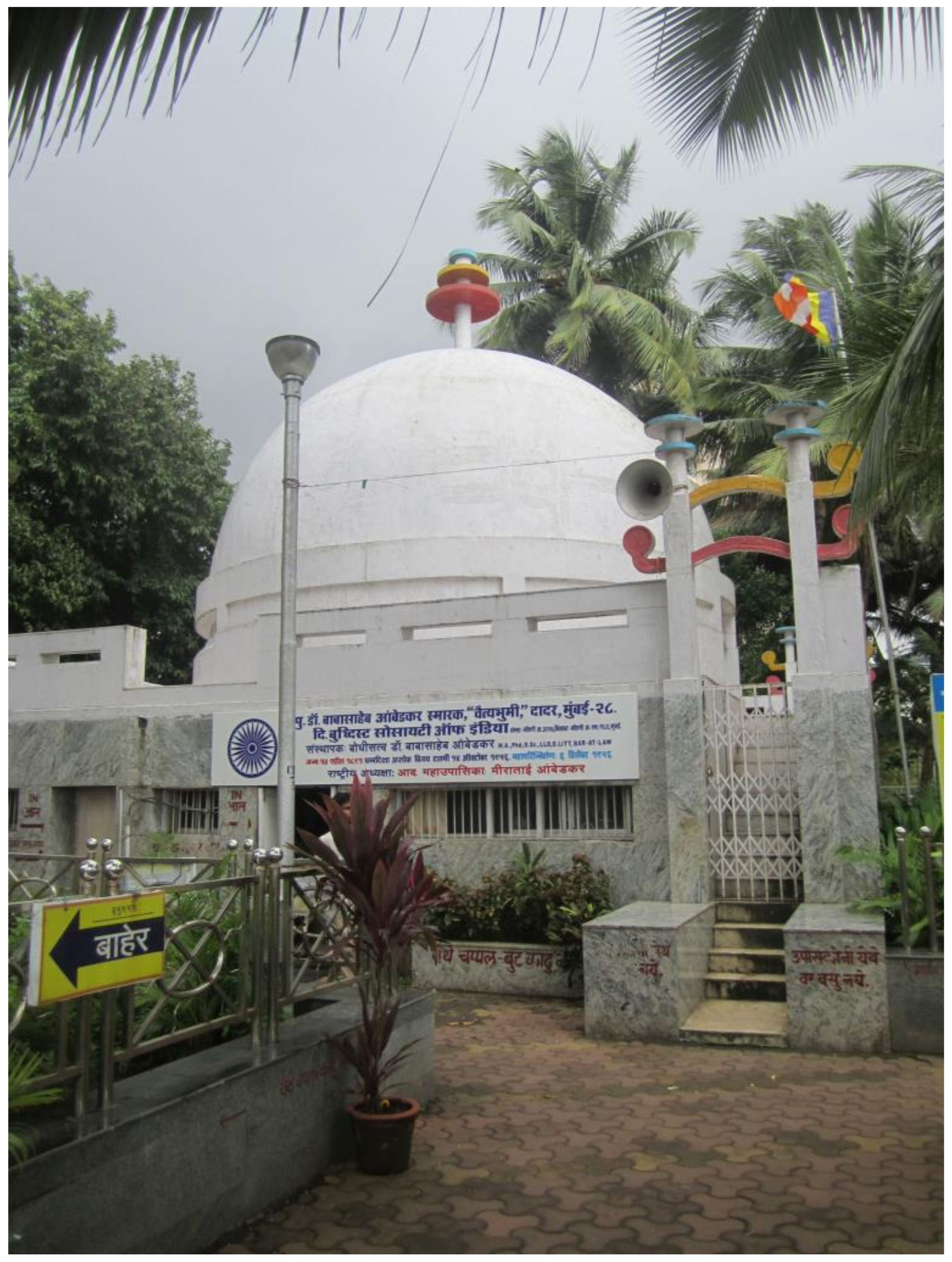
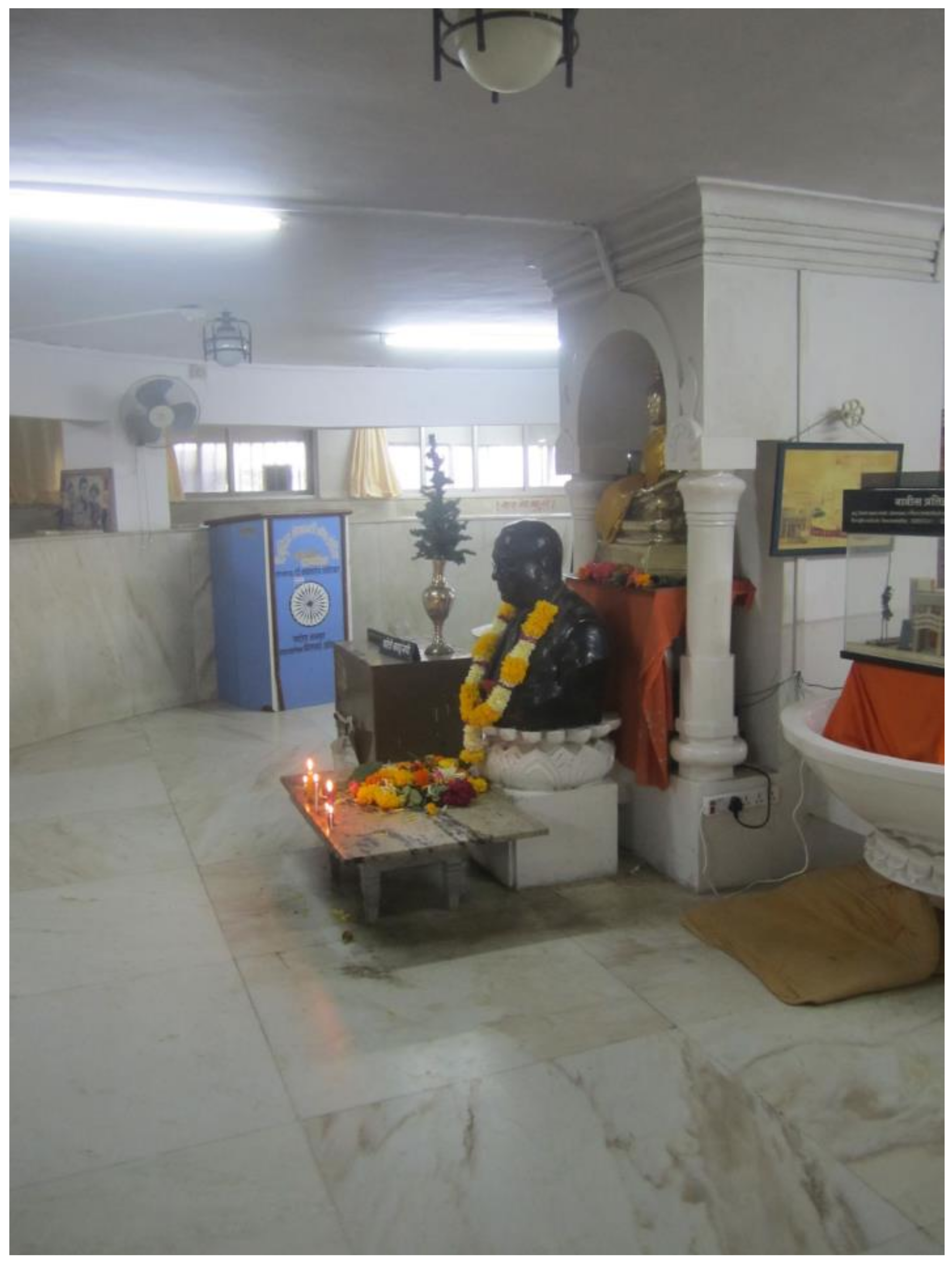
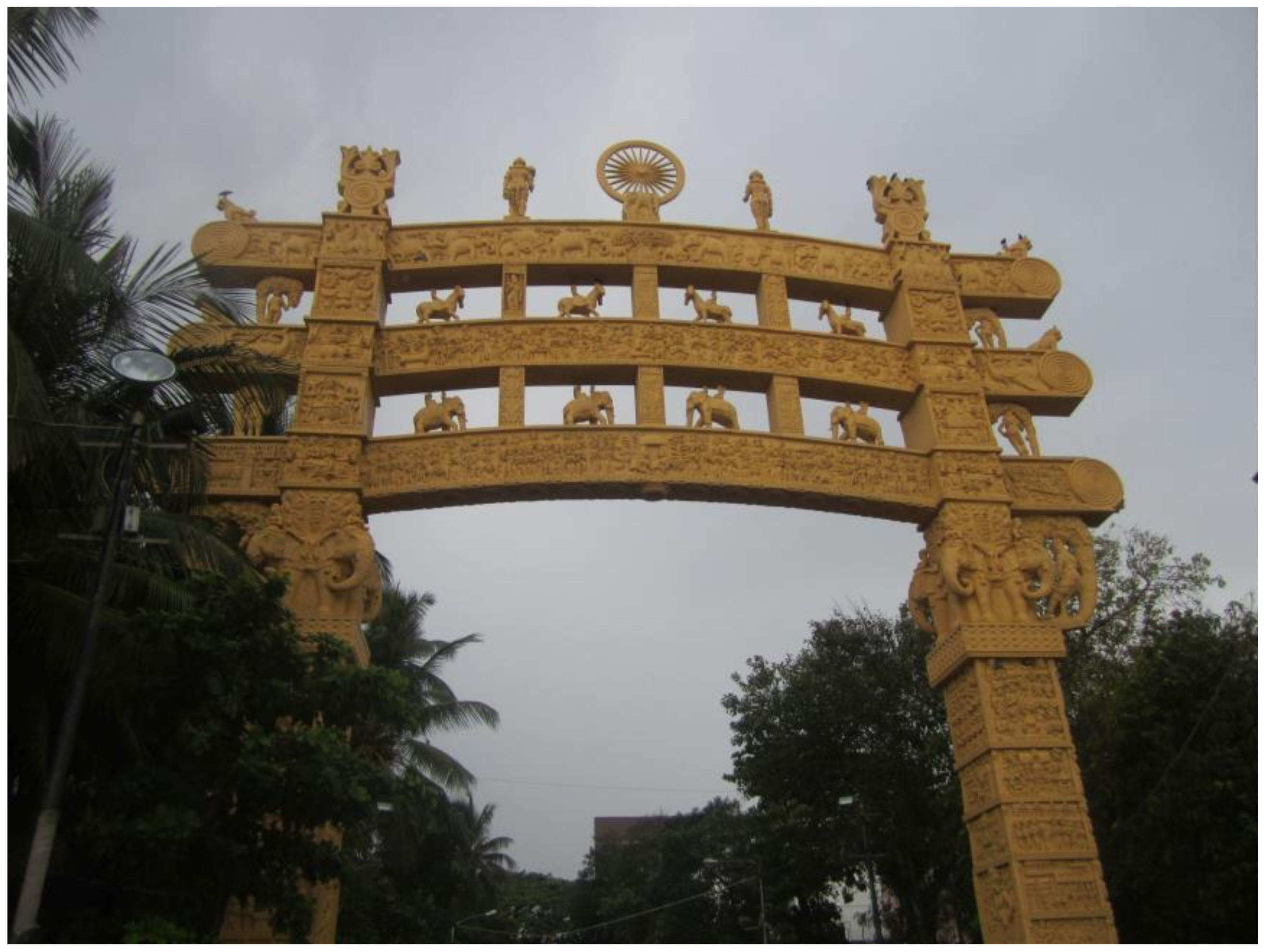
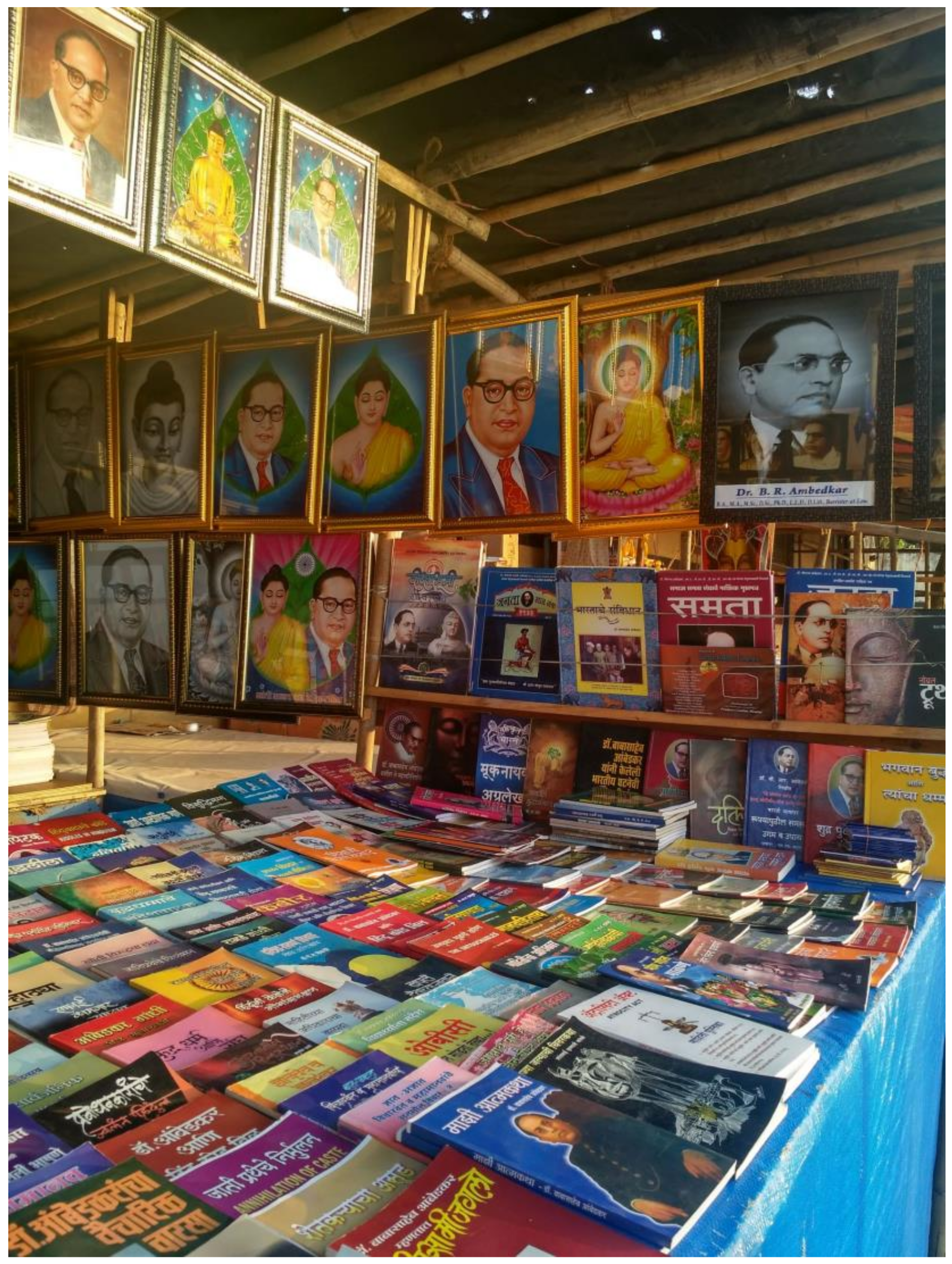
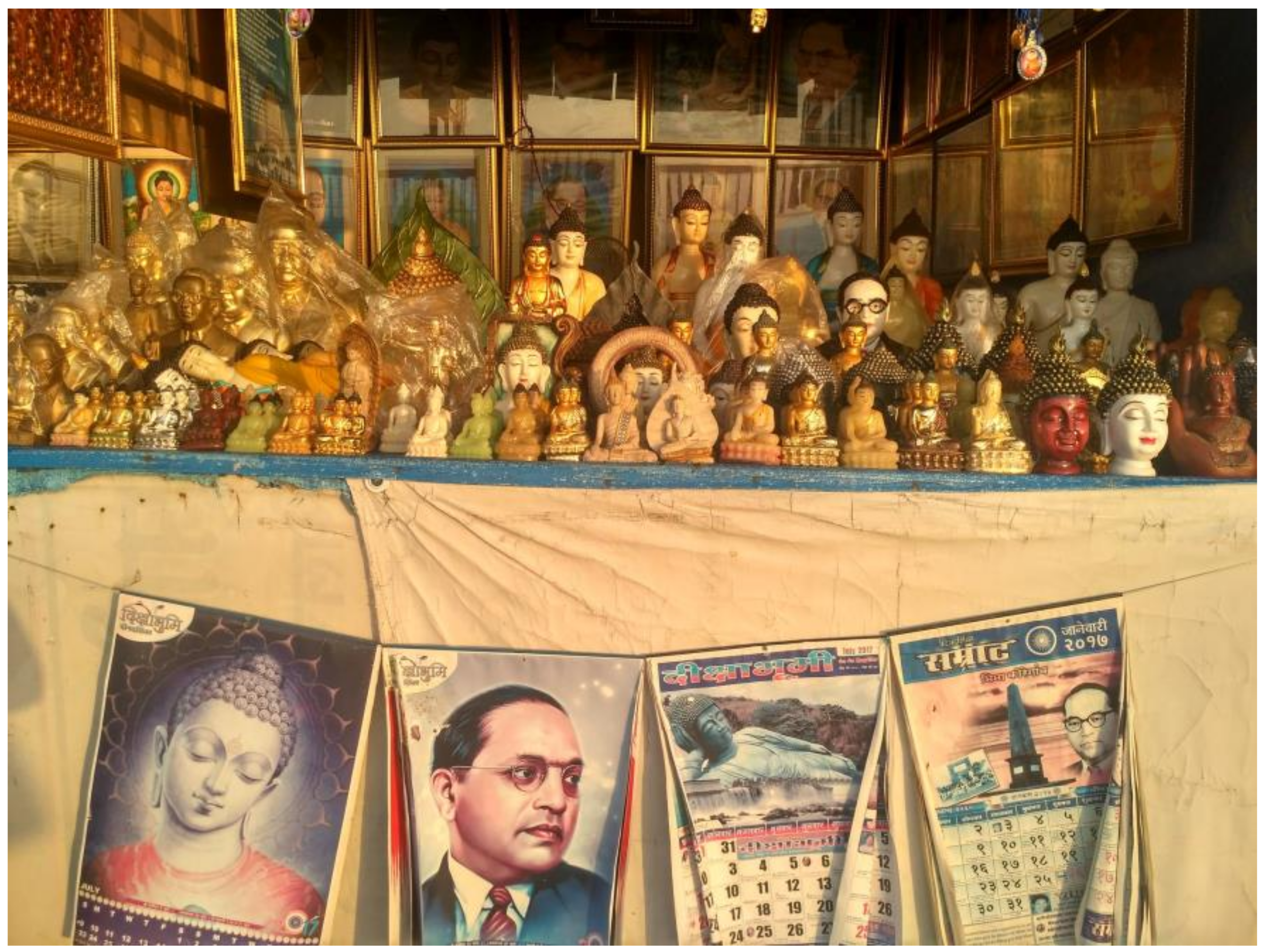
© 2018 by the author. Licensee MDPI, Basel, Switzerland. This article is an open access article distributed under the terms and conditions of the Creative Commons Attribution (CC BY) license (http://creativecommons.org/licenses/by/4.0/).
Share and Cite
Bochkovskaya, A. Heading to Chaityabhoomi: Pilgrimages of Remembrance. Religions 2018, 9, 111. https://doi.org/10.3390/rel9040111
Bochkovskaya A. Heading to Chaityabhoomi: Pilgrimages of Remembrance. Religions. 2018; 9(4):111. https://doi.org/10.3390/rel9040111
Chicago/Turabian StyleBochkovskaya, Anna. 2018. "Heading to Chaityabhoomi: Pilgrimages of Remembrance" Religions 9, no. 4: 111. https://doi.org/10.3390/rel9040111
APA StyleBochkovskaya, A. (2018). Heading to Chaityabhoomi: Pilgrimages of Remembrance. Religions, 9(4), 111. https://doi.org/10.3390/rel9040111



